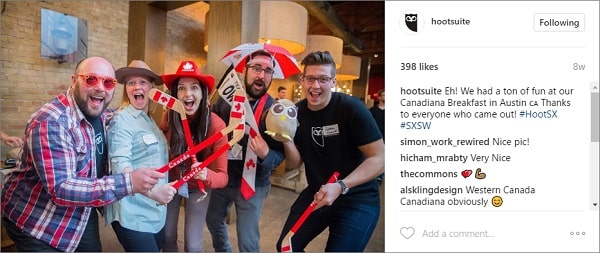If you have a business that doesn’t seem as exciting as consumer-facing businesses, like the ones in travel, entertainment, or leisure, social media marketing may seem like an uphill task. After all, how can you make taxes, fertilizers, or sales automation products interesting for social media users?
However, products or services by themselves are not “boring,” but how you market them can make audiences yawn. With some thought and creativity, you can create high-quality content that your target audience will find interesting while retaining their trust and respect.
Let’s explore ten tried-and-tested social media strategies you can use to hook your ideal customers.
1. Employ storytelling
Storytelling is especially valuable for so-called boring industries because it makes the company more humane and relatable to the audience.
How long do you think it will take before people tire of your updates about new features or upcoming products/services? Don’t treat your social media platform as a digital notice board — go above and beyond to bring real-life stories to your audience about how your company made a difference in the lives of customers.
Storytelling encourages people to engage with your brand by stirring up the right emotions. Even if your industry is not as glamorous as you’d like it to be, the results your product or service can offer could be of interest to your audience.
Proposify, an online proposal software to create custom proposals, tells a story about how its platform helps sales teams streamline their work with a relatable and funny video.
2. Educate your audience about topics that interest them
To be truly helpful to your audience, find out what they want to know. Conduct market research and create buyer personas to guide your social media marketing strategy. Then create content targeted toward the topics around which your audience is looking for answers.
Avoid self-promotional questions that you think your audience wants to know and put in the work to find out what they really want to hear about.
Turbo Tax produces focused content on Facebook to help simplify its service for audiences, such as this blog post on how freelancers or self-employed people can file their tax returns.

Source: Stevie Says Social
3. Showcase your brand personality
Your industry may be dry, but that doesn’t mean that you need to sound stuffy on social. Infuse a bit of humor in your brand tone, perhaps poke fun at yourself. Tongue-in-cheek humor is sure to catch the attention of your audience. Posts that evoke awe, laughter, amusement, and joy appear to drive much better engagement than others.
Just make sure you don’t overstep the line, or it could spectacularly backfire like Burger King UK’s tweet saying, “Women belong in the kitchen.”
Take the example of Kinaxis, a supply chain management company that put out a series of hilarious videos on YouTube comparing the world of supply chain solutions to dating. The characters in the video are tired of putting up with high-maintenance, inflexible, and outdated partners and realize that Kinaxis is the right partner. Then they meet their exes in awkward encounters who realize that Kinaxis is simply a cut above.
4. Use visual aids
Posts with at least one image have been found to get more shares on both Facebook and Twitter. You can use a variety of visual aids like infographics, memes, or comics.
Infographics are an excellent way to make facts and figures accessible and interesting. You can repurpose data from original research reports or surveys to present it in a visually attractive manner. Having concrete figures also boosts the credibility of your brand.
To streamline the work of repurposing and distributing content to the right channels, a digital asset management solution can help you organize all the disparate media assets in a central location.
Consider this tweet from Verizon Business that has a simple yet impactful graphic about cybersecurity.
The DBIR shows that #CyberSecurity breaches can take mere minutes. Discovering them can take months. Learn how you can prepare and respond faster by reading our Verizon Incident Preparedness and Response Report. https://t.co/VJQVWBko6R pic.twitter.com/4c7clcGn8J
— Verizon Business (@VerizonBusiness) August 20, 2019
5. Leverage user-generated content
A successful way to engage audiences is to give them a chance to create their own content featuring your brand. User-generated content (UGC) can be of many types: images, video testimonials, product reviews, or even comments on your posts.
You can repurpose UGC by resharing the content on your page and, in the process, reward followers and expand your reach through word-of-mouth marketing.
Hootsuite, a social media management tool, launched a #IWorkFromHere campaign on Instagram wherein they encouraged followers to download the app and share photos showing off where they were working from. The brand turned it into a competition for the best photo and offered a prize (a trip for two).

Source: Top rank blog
6. Invest in influencer marketing
People buy from people, even in B2B industries, and what better way to leverage it than by influencer marketing? Partnering with somebody “cool” or influential through sponsored posts, social media takeovers, or virtual conversations can help give your brand a lift.
Conduct research into influencers using tools like BuzzSumo to find people who are a good fit for your brand.
American Express ran an influencer marketing campaign on Instagram where it used the branded hashtag #AmexAmbassadors to promote its Platinum card. It picked influencers who led luxurious lifestyles, traveled frequently, and used the privileges available with the American Express Platinum card.
The brand worked with both mega-celebrities and micro-influencers with followings of 100,000 and below to send the message that successful people come from a wide range of backgrounds.

Source: Mediakix
7. Piggyback on trending topics
Newsjacking is the practice of using currently-trending pieces of news to promote your brand. With creativity and clever wordplay, brands can extend their reach and even go viral.
Use social listening tools like SproutSocial, Mention, or Keyhole to track hashtags, topics, mentions, and usernames, so you don’t miss the bus.
Microsoft Teams capitalized on the uncertainty around sports due to COVID-19 in 2020 by talking about its new model, “Together Mode.” For greater context for NBA and other postponed matches, Microsoft Teams used a video to show how they put virtual fans in a basketball stadium to market its new feature.
8. Promote your company culture
If you cannot think of anything interesting to talk about when discussing your brand, try switching focus to the people behind the brand.
Share stories about what makes your workplace different, spotlight the achievements of your employees, share a personal talent that an employee has, such as playing an instrument, or talk about what makes your company an awesome place to work at.
Post videos with employees talking about their day-to-day work at the office. Or, if they’re working remotely, have them describe how you’re providing them with the flexibility and support to do their jobs well.
Hootsuite does this very well on its Instagram page using the hashtag #hootsuitelife. It presents itself as an attractive company to work at and humanizes its brand by sharing everyday scenes of the workplace. It also shares photos of employees attending special events, participating in group meetings, taking part in a workout session, and even sampling sweet treats brought to the office.

Source: Top rank blog
9. Run interactive polls
There are few things like polls, snappy surveys, or contests that get followers excited and jumping in to participate. People cannot resist showing off their knowledge. You can ask trivia questions about your product, company history, or industry.
Ensure that you provide some motivation to your followers to participate, whether it be in the form of a prize, a discount coupon, or a freebie. If your question is quirky enough, the entertainment value of the poll itself will be enough to drive engagement.
Boost your reach by including calls-to-action like asking your followers to reshare the poll and tag friends.
Scan Pro Video, a manufacturer of equipment for professional video production, ran a poll around the Halloween weekend asking its followers to vote on their favorite horror film series. This poll is meant to be just fun. It’s also a way to build a deeper relationship with your followers and start an interesting conversation.

Source: Neal Schaffer
10. Showcase behind-the-scenes content
Give your audience a peek behind the curtains at what goes on out of sight of customers. Behind-the-scenes content breathes life into your social media page and feeds the curiosity of the audience. It makes your company more relatable and works well for service-based industries like funeral services, where it’s morbid to talk about everyday tasks.
Show your audience how your products are made or how your team works on bringing new features. Give them a sneak peek into how your latest update is coming along.
Maersk, an integrated container logistics company, jazzes up its Instagram page with photos of its crew going about their day as they travel across the world for work.

Related Content
- Creating Content: 5 Social Media Post Types You Can Use
- Social Media Marketing for Salons: 21 Tips and Strategies
- Which Social Media Platform Is Best For Your Business
- 5 Social Media Opportunities that You Can’t Afford to Miss
- What is Social Media Listening & How Can It Improve Your Marketing?
- What is Social Media Marketing? A Comprehensive Guide
Conclusion
Any brand, no matter how dull and unimaginative the industry, can benefit from using a combination of the strategies mentioned to boost visibility and engagement on social media. Using a storytelling approach, infusing humor and witticisms, and making the audience the hero with UGC helps give a human face to your brand.
Partner with the right influencers, put up fun polls and contests and show the audience who you really are by highlighting the people behind the brand. Show glimpses of what goes on behind the scenes at work. Ride the wave of trending topics to capture more eyeballs if you can weigh in creatively.
Put in the effort to ramp up your social media marketing efforts and go beyond talking about features, and you’re sure to generate the ROI you want.

Written by our guest writer Tim Ferguson, a writer and editor of Marketing Digest.
He helps marketing agencies with SEO, link building, content marketing, online reputation management, and blogger outreach. When he is not writing and editing for Marketing Digest, he spends time learning more about content marketing and getting better at it.



